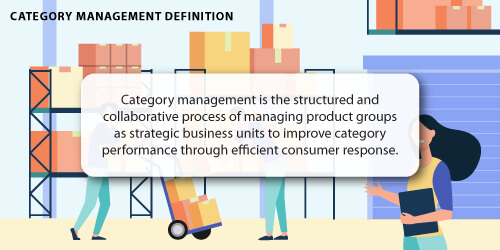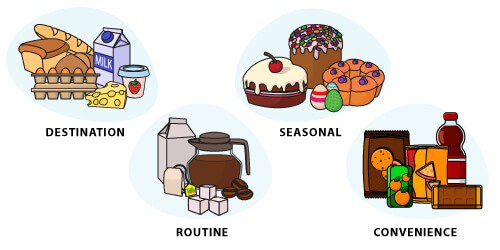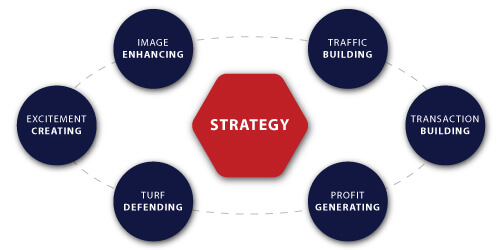Category management is vital to consider if you work in the retail industry*. Why? When implemented correctly, it enables you to provide your customers with the products they want, when they want them and at a price that suits their pockets. More importantly, you can use it to encourage shoppers to return to your store. What's not to love?

The simple answer is nothing. Category management is worth the effort, and you have everything to gain. If you're wondering how to do it best, we'd advise you to take a collaborative approach. That way, you can learn and benefit from the expertise of others if you need or want advice.
Let's say you know all this - you know category management is worth doing. You also understand that collaboration is necessary to get the best results. But what about the process as a whole? How do you implement category management in your business?
While there is debate over the number of steps involved - some say as many as eight while others peg it at five, at DotActiv, we follow a six-step category management process.

1. Define your categories
The first step in the category management process is to define your category.
How do you do that? Simply put, it comes down to putting yourself in your customer's shoes and looking at how they perceive a particular category. Another way to define your grouping is to figure out the customer need it satisfies.
It is worth pointing out that defining your category is one of the most misunderstood steps of the whole category management process.
That said, there is a valid reason for completing this step. Its purpose is to help you divide your products and services into smaller (and thus more manageable) groups. This category segmentation is also crucial because in completing it, you will develop the consumer decision tree.
The consumer decision tree (CDT) is “a graphical record that assists retailers to understand consumer buying habits better and the decision-making processes followed by individuals while shopping a category”. You can also call it a flow chart since it maps out the order in which your customers make a purchasing decision.
For example, when deciding to buy a cold beverage, you consumer could look at the price, factor in who they are buying it for (themselves or others) and the occasion. They'd also look at the packaging (size and UoM) and the actual product. Do they want a carbonated or non-carbonated drink? What flavour do they want? How large must it be?
What makes it more challenging is the point that a category can have more than CDT. Fluctuating consumer behaviour and demand and the fact that no two shoppers are alike can explain why.
For example, you could have one customer driven by convenience and functionality. Meanwhile, another customer buys based on the brand. The more expensive, the better quality, they might argue. Either way, you need to accommodate both shoppers and their individual preferences.

2. Determine your category roles
Once you have defined your category, it's vital to determine its role. The reason is simple: the category role you select determines its overall purpose. The tactics you choose will also, undoubtedly, support your high-level objective.

There are four consumer-based category roles from which to choose:
Destination
This is when you want to be the primary category provider for a particular category. You'd also expect to have a 90% market share if not more. You'll also want to aim to deliver consistently and offer superior value so that shoppers don't mind going out of their way to shop at your store.
Preferred/Routine
As the name indicates, you want to be the preferred category provider. As with the Destination role, you'd expect to have a broad range and cover up to 90% of the market. Since many other stores sell similar items, you must ensure your service is consistent while your pricing is competitive.
Occasional/Seasonal
Unlike the previous two roles, which means having a broad range across the year, here you'd need to have a timely range that meets demand head-on. You'd still want to stock the best available products, but you can't expect to have them in-store all year round. However, when a shopper wants a particular product, you want them to think of you first.
Convenience
As the name suggests, this is for one-stop shopping that is convenient for your customers and fast. You don't need to be a corner shop to provide convenience, but it's not always the product assortment you'd find on a routine shopping list. It also plays a critical role in margin enhancement.

3.Generate insight to optimise your categories
Insight generation, the third step in the category management process, relies on customer research, sales data, and in-depth analysis. Simply having this information at your fingertips is to your advantage.
The insight you generate also drives the next step - strategic and tactical planning. Before we get to that, it's essential to consider how you can gather insight.
There are three ways: Market, Consumer and Category assessment.
Market Assessment
You want to know how your products perform with your target market. Such an assessment includes looking at your performance compared to your competitors. After doing this, you'll have a better understanding of your market.
Consumer Assessment
In understanding your customer data, you can understand the purchasing behaviour of your customers. In so doing, you can find out if they are more loyal to specific brands or if they are convenience customers. As you'll note, this assessment is about getting to know your customers and looking at how they understand and perceive a category.
Category Assessment
By doing a category assessment, you're analysing the sub categories and segments of your groupings concerning your sales, profits, returns and so on. During such an assessment, you can also look at the opportunities to improve your category.
These opportunities or tactics can take the form of your product assessment, pricing, placement or merchandising, and promotion.

4.Choose the strategy and tactics to deliver your goals
Having assessed your category and understanding where you can optimise it for further gains, it's time to consider the strategies and tactics.
What strategies and tactics do you want to implement that'll allow you to deliver on your overall objectives for your category?

There are six different merchandising strategies that you can make use of:
Traffic building
This tactic is best for your Destination and Seasonal categories since the goal is to get your customers into your store to buy more. To be a success, you must always stock your top-performing SKUs.
Transaction building
This tactic is best for your Destination, Routine or Seasonal categories. The goal is to increase your customer's average spending within the category. You can achieve that by running promotions, bundling products or even cross-merchandising.
Profit generating
This tactic is best for your Routine, Seasonal or Convenience categories. The point is to increase the sales of your high-margin products. You can achieve that by merchandising such categories in high-traffic areas.
Turf defending
Also known as super traffic building, this strategy is best for your Destination categories. As the name suggests, you can use it to protect your market share and turnover. And, when implemented correctly, you can create a positive price image.
Excitement creating
Best for your Destination and Seasonal categories, an excitement generating strategy helps you meet your customer's needs by offering new and innovative products. You can be successful by discounting prices lower than the market when you have limited stock to create excitement.
Image enhancing
This strategy is best for your Convenience categories since it's about improving your reputation. A good promotional mix can help here. Mind you, the method you use does depend on your product assortment.
To bring any of these strategies to life, you need a robust and flexible category management tool to help you develop your strategy-supporting tactics.

5. Initiative development
The penultimate step is about assessing the cost of your plan against the benefits. In short, is it worth it? Once done, it's a simple case of implementation.
Of course, that's simpler said than done. To implement any category management plan, and to do so correctly, you need buy-in from all relevant parties. That includes:
- Implementing a schedule around how you'll execute your plan; and
- Understanding what resources you'll need to implement the plan.
Why?
Picture this: As a retailer, you've followed all the previous steps in the category management process perfectly. However, you fail to implement the proposed plan. What is then the point of starting a process only to stop it before it's complete?
The overall success of your category management plan relies on how well you implement it. Not how well and detailed it looks on the page.

6. Plan your launch and implement
This is the last step in the category management process. You could also include it in the above step because it's where the hard work pays off. To get it right, you must ensure that you roll out your plan according to the agreed schedule you set up in the previous step.
At this stage, you've handed the completed and signed-off planograms to your stores to merchandise your products appropriately.
It’s not the merchandiser's responsibility so much as it’s yours to ensure that everything is accurate.

Keep in mind here when having over the planograms but before implementation: you must ensure everything is accurate. That includes ensuring the planogram has the right images, fixtures and all other necessary information.
It is not the responsibility of your in-store merchandisers so much as it's yours to ensure everything is accurate.

Bonus: Review your category
While a category review is not an official step in the category management process, we highly recommend it. More importantly, we recommend you do it through the process - it can't be an afterthought.
A typical review has a five-step process:
- Monitor: You must monitor your category to ensure it's performing adequately;
- Measure: You must measure the performance of your category against your category management plan;
- Make changes: If any changes are needed, you must be flexible enough to make them;
- Maintain: If the category is performing as it should, you can look at what you need to do to maintain it; and
- Move forward: If you're happy with the progress, it's critical to not rest on your laurels but go back to the start - monitoring your category.
Why? A category review is an ongoing exercise. It's a critical indicator of the success or health of your category and can always change.

Conclusion
The category management process is not a short or simply exercise to complete. It takes a lot of time and dedication. But that’s the way it should be though. After all, anything that’s worth doing takes time.
Would you like to implement category management in your retail business but don’t know where to begin? Or perhaps you have already started and you’ve since found it confusing and overwhelming. Either way, we’re more than happy to help you maximise your efforts.
Book a complimentary custom consultation with a DotActiv expert here or browse through our various software and service on our online store here.
*This article was updated on 27 September 2022.


